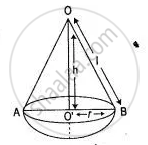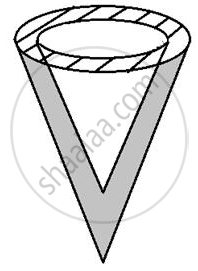Advertisements
Advertisements
प्रश्न
A buoy is made in the form of a hemisphere surmounted by a right circular cone whose circular base coincides with the plane surface of the hemisphere. The radius of the base of the cone is 3.5 m and its volume is two-third the volume of hemisphere. Calculate the height of the cone and the surface area of the buoy, correct to two decimal places.
उत्तर १
Radius of hemispherical part (r) = 3.5 m = `7/2`m
Therefore, Volume of hemisphere = `2/3pir^3`
= `2/3 xx 22/7 xx 7/2 xx 7/2 xx 7/2`
= `539/6`m3
Volume of conical part = `2/3 xx 539/6` m3 (2/3 of hemisphere)
Let height of the cone = h
Then ,
`1/3pir^2h = (2 xx 539)/(3 xx 6)`
⇒ `1/3 xx 22/7 xx 7/2 xx 7/2 xx h = (2 xx 539)/(3 xx 6)`
⇒ `h = (539 xx 2 xx 2 xx 7 xx 3)/(3 xx 6 xx 22 xx 7 xx 7)`
⇒ h = `14/3`m = 4`2/3`m = 4.67 m
Height of the cone = 4.67 m
Surface area of buoy = `2pir^2 + pirl`
But `l = sqrt(r^2 + h^2)`
`l = sqrt((7/2)^2 + (14/3)^2)`
= `sqrt(49/4 + 196/9) = sqrt(1225/36) = 35/6`m
Therefore , surface area =
= `(2 xx 22/7 xx 7/2 xx 7/2) + (22/7 xx 7/2 xx 35/6)`m2
= `77/1 + 385/6 = 847/6`
= 141.17 m2
उत्तर २
According to question.
`2/3` (Volume of hemisphere) = Volume of Cone
`2/3 ( 2/3 πr^3 ) = 1/3 πr^2h`
`4/9 (3.5)^3 = 1/3 (3.5)^2.h`
h = `(4 xx 3.5 xx 3.5 xx 3.5 xx 3)/(3.5 xx 3.5 xx 9)`
= `42.0/9 = 14/3 "m" = 4.67 "m"`
l = `sqrt (r^2 + h^2)`
= `sqrt((3.5)^2 + (4.67)^2)`
= `35/6` m
Now surface area of buoy = Surface area of right cone + Surface area of hemisphere
= πrl + 2πr2
= πr (l + 2r )

= `22/7 xx 3.5 (35/6 + 2 xx 3.5 )`
= 11 x (5.83 + 7)
= 11 x 12.83
= 141.13 sq.m.
APPEARS IN
संबंधित प्रश्न
A joker’s cap is in the form of right circular cone of base radius 7 cm and height 24 cm. Find the area of the sheet required to make 10 such caps.
`["Assume "pi=22/7]`
A bus stop is barricaded from the remaining part of the road, by using 50 hollow cones made of recycled cardboard. Each cone has a base diameter of 40 cm and height 1 m. If the outer side of each of the cones is to be painted and the cost of painting is ₹ 12 per m2, what will be the cost of painting all these cones?
`("Use "π = 3.14" and take "sqrt1.04= 1.02)`
Find the ratio of the curved surface areas of two cones if their diameters of the bases are equal and slant heights are in the ratio 4 : 3.
The circumference of the base of a 10 m height conical tent is 44 metres. Calculate the length of canvas used in making the tent if width of canvas is 2 m. (Use it 𝜋= 22/7).
What length of tarpaulin 3 m wide will be required to make a conical tent of height 8 m and base radius 6 m? Assume that the extra length of material will be required for stitching margins and wastage in cutting is approximately 20 cm (Use it 𝜋 = 3.14)
Find the volume of a right circular cone with:
radius 6 cm, height 7 cm.
Find the volume of a cone whose slant height is 17 cm and radius of base is 8 cm.
There are two cones. The curved surface area of one is twice that of the other. The slant height of the latter is twice that of the former. Find the ratio of their radii.
A heap of wheat is in the form of a cone of diameter 16.8 m and height 3.5 m. Find its volume. How much cloth is required to just cover the heap?
Find what length of canvas, 1.5 m in width, is required to make a conical tent 48 m in diameter and 7 m in height. Given that 10% of the canvas is used in folds and stitchings. Also, find the cost of the canvas at the rate of Rs. 24 per metre.
A solid sphere and a solid hemi-sphere have the same total surface area. Find the ratio between their volumes.
A solid metallic cone, with radius 6 cm and height 10 cm, is made of some heavy metal A. In order to reduce its weight, a conical hole is made in the cone as shown and it is completely filled with a lighter metal B. The conical hole has a diameter of 6 cm and depth 4 cm. Calculate the ratio of the volume of metal A to the volume of the metal B in the solid.

A cone of height 15 cm and diameter 7 cm is mounted on a hemisphere of same diameter. Determine the volume of the solid thus formed.
A solid metallic hemisphere of diameter 28 cm is melted and recast into a number of identical solid cones, each of diameter 14 cm and height 8 cm. Find the number of cones so formed.
The curved surface area of a cone is 2200 sq.cm and its slant height is 50 cm. Find the total surface area of cone. `(π = 22/7)`
Find the radius of the circular base of the cone , if its volume is 154 cm3 and the perpendicular height is 12 cm
The heights of two cones are in the ratio 1:3 and their base radii are in the ratio 3:1. Find the ratio of their volumes.
A right-angled triangle PQR where ∠Q = 90° is rotated about QR and PQ. If QR = 16 cm and PR = 20 cm, compare the curved surface areas of the right circular cones so formed by the triangle
